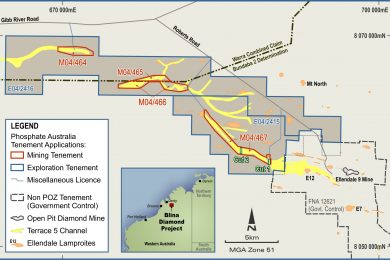Trial mining is expected to start next year on a potential prolific diamond corridor in Australia’s most famous gem producing region – Western Australia’s Kimberleys. This follows a historic Mining Agreement between Perth-based POZ Minerals and the Bunuba Dawangarri Aboriginal Corp.
The agreement covers the southern portion of POZ Minerals’ wholly-owned Blina alluvial diamond project area in the Ellendale Diamond Province in the West Kimberleys. The Bunuba are the traditional owners for this area.
This agreement has allowed the Native Title Tribunal to grant Mining leases M04/466 and M04/467, the two key licenses at the heart of the Blina diamond project.
Blina’s 40-km long diamond bearing palaeo-channel, named Terrace 5, with channel widths of 200-500 m, drains the central section of the mined Ellendale field. The Terrace 5 alluvial diamonds appear to be mostly derived from the E9 lamproite pipe, also host to the now closed Ellendale diamond mine – once responsible for half of the world’s production of rare fancy yellow diamonds.
POZ Minerals’ Executive Chairman, Jim Richards, in paying tribute to the approach by the Bunuba people in facilitating new mining opportunities, said the agreement paved the way for diamond bulk sampling and trial alluvial mining operations at Blina over 2018.
A fauna and flora survey has commenced to facilitate the grant of mining permitting.
This agreement has facilitated the Native Title Tribunal permitting the grant of Mining leases M04/466 and M04/467, two of four mining lease applications and two exploration leases within a 161 km² project area 100 km east of Derby.
Richards said diamonds previously recovered from Terrace 5 gravels are considered large, with an average stone size of around 0.4 ct. Most stones are of gem quality and a significant amount are fancy yellows.
The largest diamond recovered to date from Terrace 5 weighed 8.44 ct (from pit BLBS082), with stones larger than 2 ct common.
“The key to exploring the Terrace 5 diamondiferous channel is to find the best alluvial trap sites which are most likely to host the highest diamond grades,” Richards said.
“These trap sites usually occur around the sediment/bedrock interface. POZ Minerals has completed a ground geophysics survey using the latest in-ground penetrating radar (GPR) technology, and is assessing this data in order to generate targets for the bulk sampling program.”
The terms of the Mining Agreement with the Bunuba people include new employment and training opportunities for them, including at least a quarter of any onsite workforce consisting of local indigenous employees, earthmoving contracts, plus share options in POZ Minerals and profit share arrangements.
“We believe the Mining Agreement with the Bunuba people will have a long lasting and significant benefit for both parties,” Richards said.
“It delivers POZ certainty over tenure and future development options, including full scale mining, whilst the Bunuba group ensures that its heritage is protected and that employment, training and financial benefits will flow to the group.”
The Ellendale lamproite field which hosts the Blina project area is one of the largest lamproite fields globally and many of its pipes have proven to be diamondiferous, including the Ellendale 4 (E4) and Ellendale 9 (E9) pipes which have been commercially mined.
The E9 mine (currently not producing) immediately adjacent to Blina was reported in 2014 to be the world’s leading source of rare fancy yellow diamonds and to have contributed an estimated 50% of the global supply of these yellows.










